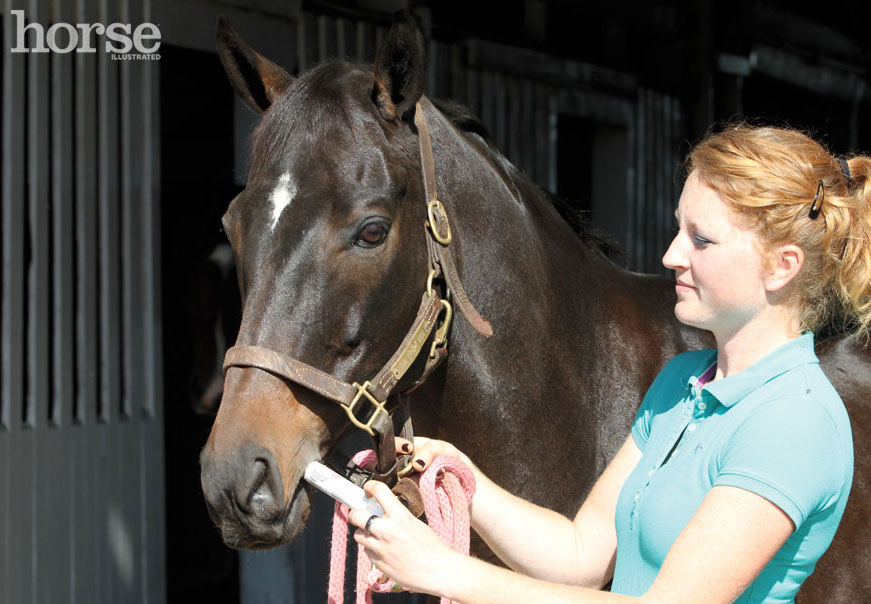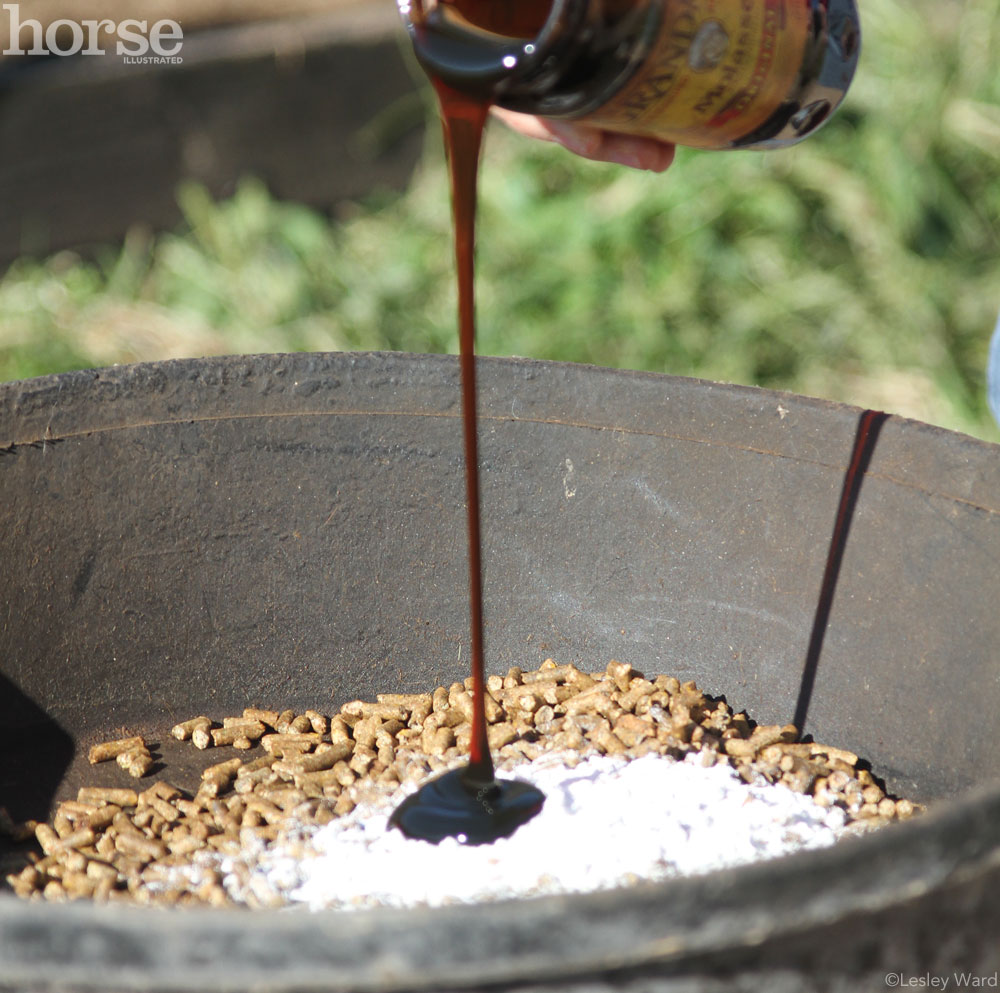
Whether it’s a twice yearly deworming, the occasional bute, or that one-off round of antibiotics, chances are you’ll have to give medications to your horse at some point. And while apple-flavored paste or pills hidden in molasses may seem to appeal to any equine, some horses will have none of it. Here are some tips and techniques to help you administer those all-important medications.
- What: Know the name of the medicine you’re giving. It’s helpful to know both the drug name and brand name, as these can sometimes lead to confusion. For example, flunixin meglumine is the drug name, but Banamine is a brand name for the drug. There can be other variations in names if there is a generic version of the drug on the market.
- How much: Knowing how many tablets to give and how often is the crux of managing your horse’s medications. Have these directions written on the medicine container and in another location as well, like a tack room bulletin board or a white board outside your horse’s stall. Then, when your horse is finished with the meds, remove the posted instructions so they don’t cause confusion in the future.
- How long: Duration of treatment will vary depending on the medication. For antibiotics, your vet will usually direct you to finish the bottle, but for pain medication, you may be directed to give on an as-needed basis. Make sure you understand how long to continue your horse on his meds.
- Why: Understanding the reasoning behind a medication is beneficial for many reasons. For example, it can give you a better appreciation of what the medicine is doing and increase compliance to the given regimen. Another benefit is that talking with your vet about how the medication works helps you remember it. Understanding the medicine’s actions and possible side effects can also help you better monitor your horse.
Most medications that owners give their horses are in oral form, but not all oral drugs are created equal—there are pills and tablets, gels and pastes, and powders to mix in the feed. You may find that no matter how well you think you’ve hidden a pill, your horse somehow sniffs it out and turns up his nose. And really, who can blame him? Many medications are bitter to the taste. Let’s take a look at each type of oral medication and how to get your horse to take them.
Find out more about administering injectable medications >>
Pills and Powders
Wouldn’t it be nice if you could just put a pill or scoop of medicated powder in a pile of sweet feed and call it a day? While some horses will happily take the sweet feed, others become suspicious. Some may take their meds this way the first time or two, but then turn their nose up the next time.
If you’re lucky enough to have a horse that accepts medicated sweet feed, be aware of the feed you’re using as bribery. If the medicine is prescribed for long-term use and the horse is prone to weight gain or laminitis, or has insulin resistance or another metabolic condition such as Cushing’s or HYPP, loading up on the wrong kind of sweets may not be a good pill-giving solution.
When mixing medication with water, beware that some medications do not dissolve well and leave sludge at the bottom of the mixing container. Mixing a crushed pill into something thicker than water, such as molasses or honey, helps bind the medication while facilitating administration. You may need to dilute the molasses with water.

Medicine-spiked molasses or other sticky agent can either be dispensed into a feed bucket or put into a syringe to be given directly into the mouth, like a dewormer. If you are giving your meds in a bucket, make sure the horse consumes all the medication and don’t leave the feed bucket around for another horse to lick. If you opt for a syringe, you can use an old, well-washed deworming syringe or purchase a large—30 or 60 milliliter (cc)—catheter-tipped syringe from your vet or feed store. These can be easily washed out and re-used for many administrations.
Before you crush or dissolve any pills or tablets, always ask your vet. Some pills are formulated as time-release capsules and need to be given whole to work properly.
The Cover-Up
Hiding pills in treats is another method of administration. Apples can be good hiding places for small quantities of pills—just slice one up and cut slits into each slice to hide a pill or two with the hopes that your horse will gobble the treat and be none the wiser. Slathering the apple in peanut butter might help a little too, but again be aware of the sugar content with at-risk horses. Cooked carrots are easy to hide pills in as well.
Often the trick to getting a horse to take his meds is all about sleuthing out his favorite flavor. Luckily, there are plenty of options. Unsweetened applesauce is a great choice, especially for overweight horses or those with metabolic issues. Jellies or jams provide a plethora of choices for the picky equine and newer natural sweeteners like agave nectar offer more choices for horses with dietary restrictions. Baby food, yogurt, pancake syrup, and even cake icing—ranging from least to most sweet—are more examples of food to mix with meds. Sometimes you have to get creative.
If you can go the pill-crushing route, you may discover that some pills seem to be made of steel; they are incredibly difficult to crush and are notorious for flying across the table in the crushing process. A sturdy mortar and pestle—easily purchased at any pharmacy—is a convenient way to crush medicine. A cheap coffee grinder is another method of efficiently crushing pills. Just remember to keep your pill-crushing tools clean and clearly marked as not for human use.
One thing to keep in mind as you attempt to get your horse to eat feed or a treat with medicine in it: you might want to try a small test batch first. That way, if he doesn’t eat it, you haven’t wasted an entire dose of medication if it has been crushed into a large scoop of sweet feed, molasses, or whatever your choice may be.
Gels and Pastes
Sometimes it’s easier to simply deliver the medication directly to the horse’s mouth rather than counting on him to eat it on his own. This can be the case as described above with crushed pills and powders and is usually required for medications that are pre-packaged as a gel or paste, such as many dewormers.
The safest way to administer a medication orally via syringe is to stand at the side of the horse’s head, never in front in case the horse rears or throws his head. Make sure there is no feed, grass, or hay in the horse’s mouth, as this increases the chances of the horse spitting everything out. If your horse has a messy mouth from wet grass or sticky feed, rinse his mouth out with either a hose or some water in a syringe.
Slowly slide the tip of the syringe into the corner of the horse’s mouth and direct the syringe on top of the tongue and toward the back of the mouth. Some people will use the other hand to hold the horse’s head down across the bridge of the nose; however, some horses become more agitated with such restraint. Have your horse in a halter when you do this—don’t try to give oral medications when there is a bit in the horse’s mouth.
After you’ve dispensed the medication into the horse’s mouth, hold his head up with his nose as high as possible. This technique encourages the horse to swallow.
Many prepackaged gel or paste medications come in syringes with dials that allow you to properly dose your horse depending on his body weight. Make sure you’ve dialed the syringe to correspond with the correct estimated body weight for your horse—not all horses need the entire syringe!
Communication is Key
One of the most important aspects of managing your horse’s medications is frequently overlooked: communicate openly with your vet. If you have any questions, your vet should be your first line of information, not the Internet or someone at your barn. Anyone outside of the vet/client relationship is not as good of a source of information regardless of how knowledgeable they may be when it comes to horses.
Secondly, if you are struggling to administer your horse’s medication, tell your vet. There may be other options. Some medications can be compounded into a different form, like from a pill to an apple-flavored paste. Ask about what options are available. Remember: Don’t get hurt trying to administer medication to your horse.
Whether it’s crushed up peppermints or a carrot dipped in molasses, chances are there is a method out there that will work for medicating your horse. With a little bit of patience and some creativity, you can medicate even the most stubborn or suspicious horse like a pro.
ANNA O’BRIEN, DVM, is a large-animal ambulatory veterinarian in central Maryland. Her practice tackles anything equine in nature, from Miniature Horses to zebras at the local zoo, with a few cows, goats, sheep, pigs, llamas, and alpacas thrown in for good measure.
This article originally appeared in the January 2015 issue of Horse Illustrated magazine. Click here to subscribe!







Thanks for some new ideas. I usually use applesauce to mix meds or dewormers. Wormers because I have short fingers to use the plunger. Also use a round bowl, so there are no hidden corners for meds to stick.
These ideas actually sound “yummy”. Grandma’s old saying, “a teaspoon of sugar makes the medicine go down”.
great info
Why can’t they come up with some flavor pill pockets like they do for dogs?